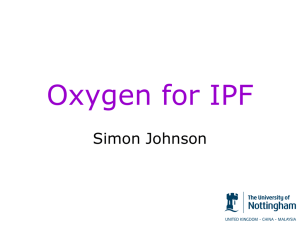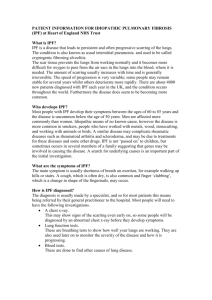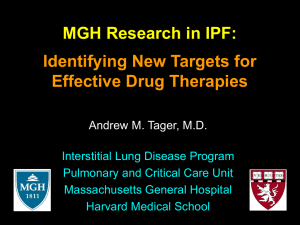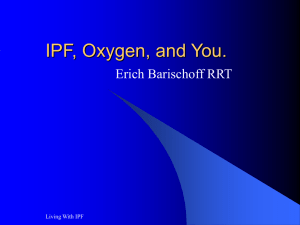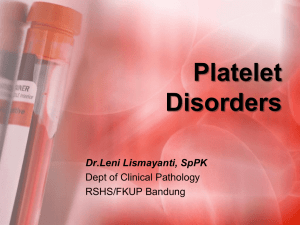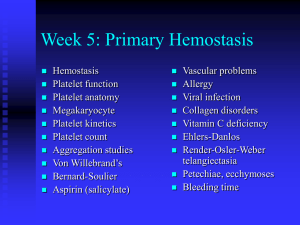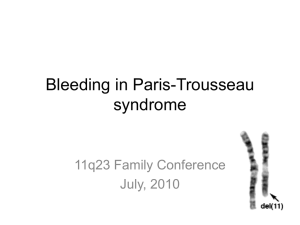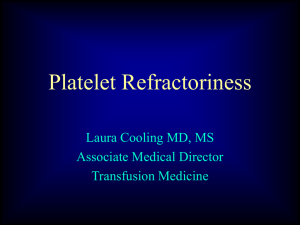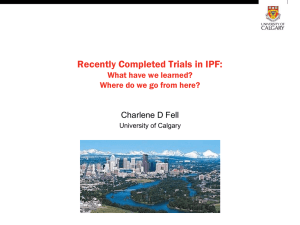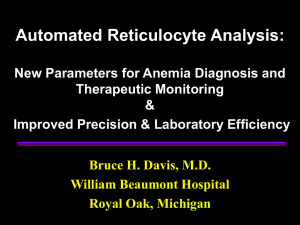Newer parameters and managing CBC Services with a 5 Part
advertisement
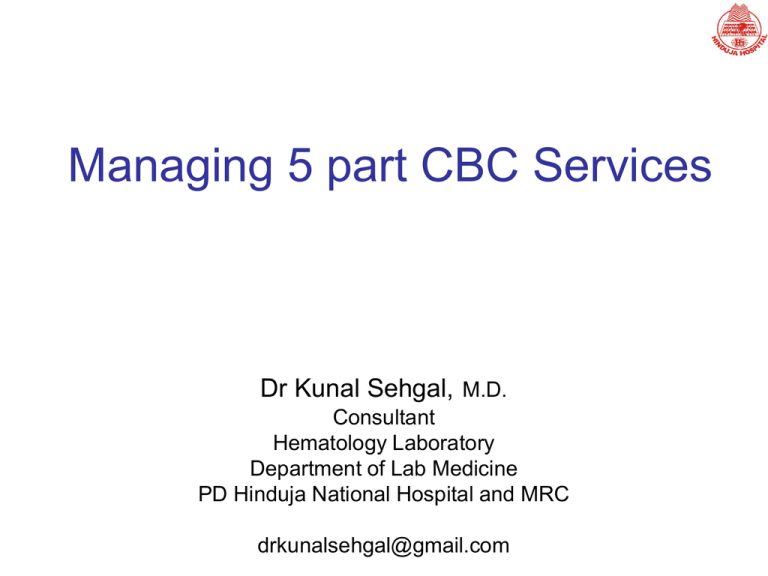
Managing 5 part CBC Services Dr Kunal Sehgal, M.D. Consultant Hematology Laboratory Department of Lab Medicine PD Hinduja National Hospital and MRC drkunalsehgal@gmail.com Automated Cell Counters 3 part vs. 5 part What is the Diff? 3 part vs. 5 part Cell Counter 3 part 5 part Differential count Neutrophils, lymphocytes, mixed Neutrophils, lymphocytes, monocytes, eosinophils and basophils Peripheral Smear Is a must PS can be made based on validated flag rules Ease of use and maintenance Easy with minimum no of reagents and processes Requires skilled staff adequately trained for operation and maintenance Cost Cheap Relatively Expensive 3 part vs. 5 part Cell Counter Principle of operation 3 part Impedance based 5 part Impedance based Fluorescence Flowcytometry (Sysmex –XE,XN series, Abott Cell Dyn) Volume Conductivity Scatter (Beckman coulter – LH series) Peroxidase staining (Seimens Advia) Additional parameters - •Reticulocyte Count •NRBC •Immature platelet fraction •Immature granulocytes •Additional Scattergrams and flags Ease of Use 3 part 5 part Machine initiation and Software Easy automated process Multiple steps. Requires technology savvy personnel. No of reagents 2 to 3 5-15. Inventory management is critical End user maintenance Simple Complicated and requires training Cost per test • 3 part counter – Cost of 2-3 reagents per Cycle – Sleep mode and startup –shutdown cost – Controls – Taxes Approximately Rs. 20-30 per (CBC+Diff) test all inclusive Details required for Costing • Average no. of Samples per day for 25 days a week or 300 days a year • Startup shutdown cycles per year- 300-365 Sr. No. 1 Cell Pack DCL 2 Pack size (ml) Price / pack (Rs.)# CBC +NRBC CBC+WDF+NRBC CBC+WDF+RET+NRBC Cycles / pack Cycles / pack Cycles / pack 20000 3500 714 606 488 Sulfolyser 3000 20000 6000 6000 6000 3 Lysercell WNR 8000 33000 5333 5333 3200 4 Fluorocell WNR 164 43000 8200 8200 8200 5 Lysercell WDF 8000 32000 0 5333 5333 6 Fluorocell WDF 84 39750 0 4200 4200 7 Cellpack DFL 3000 16000 0 0 2000 8 Fluorocell Ret 24 38000 0 0 1200 9 Fluorocell PLT 24 38000 0 0 0 Cellclean 50 7030 0 0 0 10 • • • • Reagent Derive Cost per Cycle Derive cost per test Add cost of Controls Cost for repeats and wastage Cost per Cycle (CBC +NRBC ) 19.66 Cost per Cycle (CBC+ WDF +NRBC) 36.00 Cost per Cycle (CBC+WDF+RET +NRBC) 81.20 Cost per test 5 part counter – Cost of reagents per Cycle – Complicated process – Start up and shutdown costs – significant addition to costs and is volume dependent – Controls – expensive, short expiry , cost is sample volume dependent – Taxes – Hidden costs – Always account for Dead volume, background checks, repeats, wastage, EQAS, etc – Re evaluation of costs after six months - ‘Consumption based Costing’ is a must Reagent Rental vs. Outright purchase vs. Partial Reagent Rental Approximately Rs. 50-70 per test (CBC+Diff) all inclusive 3 part Analyser NO. 4 Date: MODE: WBC RBC HGB HCT MCV MCH MCHC PLT 3 part Diff 18 parameters 9/10/95 15:11 Whole Blood 5,8 x 103/µl 4,84 x106/µl 13,7 g/dl 42,0 % 86,8 fl 28,3 pg 32,6 g/dl 257 x103/µl Leucocyte Histogram WBC Lymphocytes in % and absolute Eo, Mono, Baso in % and absolute Neutrophils in % and absolute 300 LYMPH% MXD% NEUT% LYMPH# MXD# NEUT# 31,2 6,8 62,0 1,8 0,4 3,6 % % % x103/µl x103/µl x103/µl RBC 250 RDW-SD 40,0 RBC - Histogram RBC Distribution Curve fl PLT Platelet Histogram 40 PDW MPV P-LCR 13,1 10,4 28,1 fl fl % PLT Distribution Curve Mean PLT Volume Share of bigger PLT 5 part Analyser Principles of 5 part instruments Impedance and Optical Light Scatter combined with Volume Conductivity Scatter (Beckman coulter – LH series) Peroxidase staining (Seimens Advia) Fluorescence Flowcytometry (Sysmex –XE,XN series) Basic parameters on a CBC Analyzer • Basic hematological parameters – Hb, Hct, RBC Count – WBC with Differential (3 part/ 5 part) – Platelets • Derived parameters RBC: MCV, MCH, MCHC, RDW PLT: MPV, PDW, P-LCR • Histograms / Scattergrams Additional parameters • Principle of measurement • Clinical relevance and uses • Limitations Novel parameter Machines Clinical uses Limitations Am J Clin Pathol 2008;130:104-116 Immature reticulocyte fraction Sapphire; Pentra 120 DX; LH 750; ADVIA 2120, XE 2100 Classification of anemias; monitoring the efficacy of therapy in nutritional anemia; early identification of marrow regeneration (after bone marrow transplantation or chemotherapy); Not standardized; reference intervals method-dependent; higher sensitivity in fluorescence-based analyzers Reticulated platelets XE 2100 Differential diagnosis for causes of thrombocytopenia Reduced availability; Lab ranges need to be derived Immature granulocytes XE 2100 Diagnosis of bacterial infections Reduced availability Nucleated RBCs Sapphire, Pentra120 DX, LH 750, ADVIA 2120, XE 2100. Diagnosis of hematologic diseases; prognostic factor in patients from surgery department or undergoing stem cell transplantation; evaluation of the efficacy of transfusion therapy in thalassemic syndromes Higher performance On fluorescence Based methods RBC fragments ADVIA 2120, XE 2100 Diagnosis and monitoring of microangiopathies Reduced availability; not standardized; CHr, Ret He ADVIA 2120, XE 2100 Diagnosis of iron-deficient erythropoiesis Reduced availability Hematopoietic Progenitor Cell mode XE 2100 Surrogate for CD34 stem cell quantitation Reduced availability, high imprecision Reticulocyte Count New Report Format Manual Reticulocyte Count • • • • Tedious Labour Intensive Subjective Very High CVs Automated Reticulocyte Count PROS • • • • Rapid Reproducible Reliable Research parameters CONS • Expensive • Different machines use different dyes and techniques • Standardisation is difficult • Reference ranges to be established by every lab Interpretation of Retic Count High Retic Count Low Retic Count Hemolysis Nutritional DeficiencyIDA,B12 deficiency Aplastic Anemia Response to therapy Post Chemo-radiation Repopulating BM BM infiltration- benign or malignant diosorders Blood Loss Normal Sample 17/M Anemia- Hb-5.3, Retic-18.13%, Normal Ranges at PDHNH Reticulocyte % Range- 0.39%-1.85% Literature – 0.2 - 2.5% Hb- 8.7 , Retic – 0.2% Case of anemia with low retic Normal Ranges at PDHNH Reticulocyte % Range- 0.39%-1.85% Literature – 0.2 - 2.5% Hb- 5.8 , Retic – 4.73% Case of anemia with high retic low RPI Reticulocyte Production Index-RPI PB BM 1 3 1.5 2.5 2 2 2.5 1.5 RPI Interpretation •RPI is used for evaluation only in anemic patients •RPI < 2 with anemia - Decreased production of reticulocytes and therefore red blood cells. •RPI > 2 with anemia - loss of red blood cells (destruction, bleeding, etc) with increased compensatory production of reticulocytes Normal Hb-16.3, Normal Platelet Count-214, Normal RPI-1,Normal IRF and IPF Normal Ranges at PDHNH Reticulocyte % Range- 0.39%-1.85% Literature – 0.2 - 2.5% Hb- 5.8 , Retic – 4.73% Case of anemia with high retic low RPI Normal Ranges at PDHNH Reticulocyte % Range- 0.39%-1.85% Literature – 0.2 - 2.5% 17/M Anemia- Hb-5.3, Retic-18.13%, Normal Ranges at PDHNH Reticulocyte % Median- 0.92% Range- 0.39%1.85% Heilmeyer Staging PB BM 4 3 2 1 Normal Range at PDHNH IRF 1.9 %-17.9% LFR 81.5%-98.1% MFR 1.9% -16.08% HFR 0 % -3.39% Normal Hb-16.3, Normal Platelet Count-214, Normal RPI-1,Normal IRF and IPF Normal Range at PDHNH IRF 1.9 %-17.9% LFR 81.5%-98.1% MFR 1.9% -16.08% HFR 0 % -3.39% 17/M Anemia- Hb-5.3, Retic-18.13%, Normal Range at PDHNH IRF 1.9 %-17.9% LFR 81.5%-98.1% MFR 1.9% -16.08% HFR 0 % -3.39% Clinical Use of IRF Repopulating BM Indicators of haematopoietic recovery after bone marrow transplantation: the role of reticulocyte measurements. d'Onofrio G, Tichelli A, Foures C, Theodorsen L. Universita Cattolica, Roma, Italy. Abstract The aim of this project was to study haematological recovery in patients following different types of bone marrow transplantation (BMT). Among 12 different variables, the parameters with the highest specificity or predictive value for monitoring recovery were the absolute neutrophil count (ANC) of 0.5 x 10(9)/l, an absolute reticulocyte count (RET) above 20 x 10(9)/l high fluorescent reticulocyte fraction (HFR) above 5%. Among these variables, the HFR fraction was the earliest and most sensitive index of engraftment in 79.1% of patients, HFR recovery requiring a median time of 13 days after infusion, in comparison with a median period of 19 and 18 days, respectively, for RET and ANC (P<0.0001). Platelet Parameters • Optical Platelet Count • Immature Platelet fraction Advantages of Optical Platelet Counting Optical Platelet Enumeration Microcytic RBC Giant PLT 31/F,Blood Donor, East Indian Origin, Normal Hb and WBC, Impedance Plt- 134, Platelet O –162, Morphologically- Many Giant platelets Immature Platelet fraction IPF Immature PLT are identified by its increase in fluorescence (more RNA), FSC is also higher. Immature Platelet fraction 1) Pathogenesis of low platelet count: – – Increased destruction or usage: Increased IPF High IPF suggests an active bone marrow. (e.g., ITP) Decreased production: Reduced IPF Low IPF suggests depressed bone marrow function 2) Bone Marrow regeneration : IPF - First indicator of bone marrow regeneration FDA approved IPF - Normal Range IPF – Various studies have shown Normal range as 0.5 to 5.2%, 1.1 to 6.1%, 0.5 to 3.2 % Normal Ranges Derived at Hinduja Hospital • IPF - 0.7- 4.3% Normal Hb-16.3, Normal Platelet Count-214, Normal RPI-1,Normal IRF and IPF Normal Ranges Derived at Hinduja Hospital • IPF - 0.7- 4.3% 15/f with petechial rash and thrombocytopenia -17x103, ITP -17x103,IPF-31.4% IPF-31.4% Normal Ranges Derived at Hinduja Hospital • IPF 0.9-5.6%, mean-2.35% Dengue NS1 Ag positive – KHAR HNH Platelet - 27000, IPF – 26.1% Parameters Measured – Platelet count – IPF Within 6 hrs of receiving the sample DAYS 1 2 3 4 5 6 PLATELETS 89 54 39 47 70 123 IPF 7.8 11.2 13.9 13.3 7.7 6.5 140 16 14 12 10 8 6 4 2 0 120 100 80 60 40 20 0 1 2 3 4 days 5 6 Platelet IPF IPF in Dengue • IPF IS A POTENTIAL TOOL FOR PREDICTING PLATELET RECOVERY IN DENGUE PATIENTS HAVING THROMBOCYTOPENIA. • A SINGLE VALUE OF >10% IS INDICATIVE OF PLATELET RECOVERY WITHIN 24-48 HRS IMI Channel Clinical significance of Immature Granulocytes • Found in the bone marrow in healthy individuals • Their presence in the peripheral blood is indicative of – – Systemic inflammation and sepsis – Haematological disorders like MPNs – Bone marrow infiltration A Known Case of CML Accelerated Phase Morphologically- 14% blasts, 5% basophils, 3nrbcs/100WBCs 21/F, On Chemotherapy, Post GCSF Morphologically 6%Myelocytes, 6%Myelocytes, 4%Band Forms Summary • Many new parameters have been added to the conventional CBC. • Increased sensitivity and precision (e.g., IGs, nRBCs). • Parameters like Ret-He do not have another comparable/ manual method, making such a parameter invaluable • Improved Turn around Time Summary • IPF gives insight into the pathogenesis of thrombocytopenia. Can help avoid unnecessary BM examination and platelet transfusions. • Newer parameters add a lot of extra information to the standard CBC, which may translate into better patient care. • Novel Parameters still need to be standardised across instruments and labs should make their own normal ranges before using them

